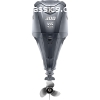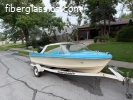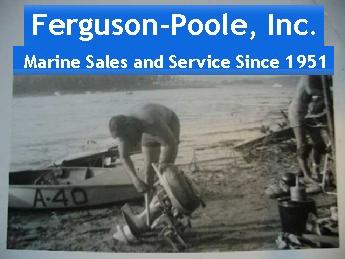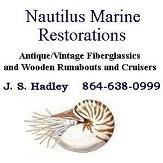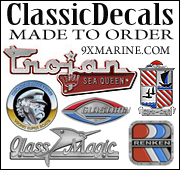FiberGlassics® would like to thank Jamil Mehdi for this article. This content is copyrighted, and cannot be reproduced without permission in any form without written permission from the author.
Boat Painting pt. 2
The Finish
By the end of Part One of this article, the boat had been cleaned, the hardware removed and bagged, the nicks, dings, and gouges repaired and filled, and the boat has been faired.
The time is almost at hand to start applying the finish. The money shot. But not quite yet...
The first step in Part Two is to wait. A day or two should suffice. The fairing compound you've used, whether it's epoxy based or polyester based, will shrink as it cures. You want to allow as much time for shrinkage as you can, but you still want to finish in a timely manner.
Epoxy takes weeks to reach full cure and will continue to shrink until that cycle is complete, though at a diminishing rate. After 24 hours (at normal ambient temperatures of 60-75 degrees), the epoxy should be about 90% cured. After that, the rate of shrinkage slows down significantly, but not completely.
Polyester fairing compounds will shrink more than epoxy and will do so at a slightly more even rate. This means that while most shrinkage of epoxy occurs in the first 24 hours, polyester might take 48 hours to get to the same point, (the variable here is the amount of catalyst added to the polyester based fairing compound), but polyester's cure rate is less of a parabolic curve than epoxy's.
I'm not saying you should wait three months after fairing, but you should give it a few days to settle down. Then go back and check it again. Is there print through of the fiberglass weave underneath? Have low spots reappeared? Is it perfect? And, if it isn't, does that mean you have to break out the fairing compound again?
Not necessarily. Obviously, only you can tell when the surface is good enough. If it passes the fresh water gloss test to your eyes, then it's time to move on. If not, you will have to decide if the next step; application of the surfacing primer, is going to absorb the surface imperfection, or if you need to repeat the steps for fairing. If more fairing is in order, give it another day or two after applying the compound before checking again.
Side note: Surfacing primer is not a substitute for fairing compound. Its dry film thickness is 6-8 mils which is about as thick as three sheets of paper, and that's before block sanding it smooth in preparation for paint.
The next step is to sand the whole boat with 150 grit sandpaper. Use the same block sanding techniques descriped in Part One to ensure a fair surface. This is the final sanding step prior to applying primer.
After sanding, vacuum the whole boat using a shop vac with a brush attachment. Be thorough, (as always), and pay attention to the areas surrounding the boat. If your are working in your garage, vacuum the walls, the shelves, the floor, your grandfather's barcalounger in the corner; whatever's near you.
Side note: Dust does more than add blemishes to the finish. It mechanically weakens the bond between coatings. To do all this work only to have it compromised by a lackadaisical attitude toward dust control doesn't make sense.
You know what comes next; wipe down the whole boat with denatured alcohol using the two-rag method described in Part One.
Sidenote: Draping 1 mil overspray sheeting over everything near you will not only keep dust down, but will also protect your weed whacker from the inadvertent paint or primer drip. It's cheap enough to replace after each round of sanding and will make a world of difference when applying a high gloss finish.
Side note: Just to reiterate, this article is intended as a guide for the recreational boat refinisher. The assumption is that you don't have access to professional spray equipment, or the requisite experience shooting LPUs to give you a professional finish. This article further assumes that you have a healthy fear of the occasional dying that occurs when inexperienced painters start messing around with atomized isocyanates without proper safety equipment. For this reason, this article assumes you'll be rolling and tipping your finish, (a finish that, if applied properly, will be indistinguishable from a professional spray application).
For minor variations in the fairing process, Awl-Quik surfacing primer, thinned with T-0031 brushing reducer, is a brushable, easily-sanded, medium-build primer that also works as a final prime coat prior to topcoating. It is a two-part epoxy primer that lives in the gray area between high-build primer and Awl-Grip 545 finish primer, yet, unlike most compromises in boat painting, this one actually does both pretty well.
You should mix the primer in a graduated mixing pot that has both fluid ounce measurments and mixing ratios.You want a mixing pot that is big enough to hold the right amount of paint, but, if it's too big, you'll create so much surface area that's exposed to air, that the solvents will evaporate too quickly.
I use one-quart paint pots most of the time. One-quart pots will allow you to mix up to 24 oz. of thinned paint or primer without spilling. This usually means I'll have to mix up two batches of primer for one full coat over a 16' – 18' boat, but I would rather mix it up twice and have it flow better, than mix up a bunch at once and have it begin to kick before I'm finished with the application.
Side note: Paint is another matter altogether and goes on considerbly thinner, but I'll save that bit for later.
Like I said, it's a two part epoxy primer, and, like all epoxy primers, it needs to be measured carefully. Precision is rewarded with LPUs. Mix equal parts base and catalyst, (to get 24 oz of primer, you should add 8 oz of each), but don't add the thinner yet! Mix the primer for five full minutes, stirring slowly to avoid air bubbles
Side note: The primer base contains the solids that make the primer both high-build and easily-sanded. When opening the can, the primer will appear white and ready to go, but don't be fooled. Most of the solids will be in a clay-like clump at the bottom of the can. Mixing this stuff is a paint in the ass, but it needs to be done thoroughly prior to adding the catalyst.
After the base and catalyst have been mixed, cover the pot with a clean something to keep airborne dust out of it, and leave it alone for the next 15 minutes. All LPU coatings have an induction time where the two parts have to chemically react prior to coating. The induction time varies with product, so always check the manufacturer's recommendations first.
After the induction time, (15 min), you can now add the reducer, (50% by volume of catalyzed primer - 16 oz of primer gets 8oz of reducer). The thinner is the same as with the paint, Awl-Grip slow brushing reducer #T-00031.
Before we get to the application, I want to talk about the ancilliary materials first. A roller cover you use to paint your den and paint brush from Home Depot is going make all your hard work look like garbage. Here is where the costs tend to pile up and, coincidentally, here is where most people make the mistake of cutting corners. For every hour of painting, you'll probably have 20 or 30 hours of preparation behind it. Don't go amateur at this point, because every corner you cut is going to be visible for the life of the finish (decades, not years).
If you can't find the products I recommend, or suitable alternatives, locally, you can order them online from a number of marine suppliers. In the Pacific Northwest, Fisheries Supply in Seattle. In Southern California and the Southwest, San Diego Marine Exchange. In Florida and the Southeast, Merritt Marine in Ft. Lauderdale. And in the Northeast, Jamestown Distributors. (Incidentally, all of those mentioned can also mix up custom colors of Awl-Grip if you want to color match your existing gelcoat).
I'm sure there are others I'm unaware of. I avoid West Marine for two reasons; they are prohibitively expensive and it seems like for every good product out there, they have substituted it with an inferior “West Marine” brand product that they tell you is just as good. On the other hand, they can often get the product you want from one of their wharehouses in a timely fashion, which isn't always the case with some of the others.
One last thought on the subject, then I'll get back to the products. Some of the paint products, by law, cannot be shipped by air. If there is not a distibutor locally, you should order your paints, primers, catalyst and reducers well in advance to ensure they'll be there when you need them.
OK. The materials for prime and topcoat applications.
Tape: I have avoided the mention of tape because the assumption is that all hardware and other impediments have been removed from the boat already. Still, there is always a need for tape, whether it's around fittings that can't be removed or for two-tone paint jobs.
Not all tape is equal. Not even all blue painter's tape is equal.
If you look at the inside of the cardboard on a roll of 3M blue painter's tape, you'll see a number. #2090 is the stuff you see at Home Depot. It is a medium-adhesive standard crepe paper tape that we all have laying around. It's fine for use in filling and fairing or for running beads of sealant. You can use it for priming, though I prefer not to. This tape is rated for 14 days, but should be removed and replaced after 7 days. Never allow any tape to adhere for more than half of it's stated rating. Just because it can be removed cleanly after a certain time is no guarantee it will be.
For priming and topcoating, #2080 is better. It has lower tack adhesive that is safer to use on freshly painted surfaces. This is 30 day tape.
For finer paint lines and more conformability to curves, 3M Perfomance Masking Tape #233 (green) is excellent tape, but don't use it on top of recently painted surfaces. It's high-tack adhesive can lift fresh paint.
For graphics and razor sharp paint lines, 3M fine line is the best, but also the hardest to use. It deforms easily and it's low-tack adhesive will allow rolled and tipped paint to bleed underneath if not properly burnished.
If you're only going to buy one type of tape for all situations, get the #2080.
Rolling pans: I have only two recommendations when it comes to rolling pans. First, buy two 6” pans. Two pans because one is to hold the paint while the other is used dry to remove excess paint from the roller, and 6” because, on a small boat, a 10” roller is too big to use and a bigger pan allows the solvents in the paint to evaporate too quickly. My second recommendation is to buy an armload of disposable paint pan liners and throw them away after each coat.
Rollers and Roller Covers: As mentioned above, get a 6” roller. Also get a 3” roller for tight spots. As for the roller covers, these are very important and the wrong one will be a nightmare. For LPU and single-part poly paints, only use a solvent-resistant foam roller cover. Any napped cover is going to hold too much paint.
LPUs are incredibly thin paints. Film thickness of a coat of Awl-Grip is about 2 mils. That's as thin as a single sheet of paper. Too much paint (the most common problem for first-timers) leads to drips, sags, and solvent pop, (this is where the paint skins over before the solvents have had a chance to evaporate, the solvent builds up pressure behind the skin until it erupts like a tiny voncano – commonly mistaken for fish-eyes which is actually the result of a contaminated surface).
The advantage of a foam roller is the amount of paint it holds. Even then, you should roll out the excess in a dry pan to avoid drips. If you have to use napped roller covers, the nap should be no longer than 1/8”.
Brushes: You're going to need three or four good brushes. By “good” I mean high quality Badger Hair or, if you can find them, Ox Ear-Hair. Yup, hair from an Ox's ear (How would you like to have that job? A livestock ear-barber). There are several manufacturers, the most widely available of which are Corona and Redtree. And there are several different tips available. For tipping, avoid flat or chisel tipped brushes, oval tipped will allow a clean brush stroke through the paint.
For a small runabout, I recommend, at a minimum, a 3” and 1” brush for tipping, and another 1” thinner brush for corners and around hardware. The thicker (not wider, but thicker) a brush is, the better the tipped surface will be, however one small thin brush that can get into tight corners where a roller can't reach is nice to have.
The signs of a good quality brush, aside from the genetic make up of the bristles, are a tight skirt that doesn't lose bristles (look for double crimps around the skirt), and most importantly, flagging of the bristles. Flagging is nothing more than split ends. Hold a brush up to the light and spread the bristles apart. Each bristle should split into two in the last quarter inch. Flagging doubles the amount of contact between the brush and the work surface.
Now is the time to plan your attack. When you start, you don't want to stop until your finished. Look at the project piece and decide where to begin in order to paint the whole thing without losing your wet edge. This is not as easy as it sounds. The most dificult aspect of rolling and tipping is keeping a wet edge. Many times, I've painted complex area of boats, like the smooth drainage channels between the non-skid on the deck of a sailboat, that's led me to have two or three wet edges going at the same time.
On a hull, the decision is easy; start at one corner of the transom and work your way around the boat. On the topside it gets a little trickier. There are curvy bits and other parts going off in different directions. Think of the primer as practice for the topcoating. You'll have three chances to figure out how to get all the way around the boat without a lap line anywhere. If you find yourself with two wet edges, don't panic. Just work in smaller increments, first one, then the other until you either finish or are able to rejoin them into a single wet edge.
Side note: Sadly, this is sometimes just a physical impossibility. In such a case, take a tip from the guys who install laminate countertops in kitchens. When a single sheet of laminate isn't big enough to do a whole counter, they don't put the seam right there in the middle of the counter. They hide it behind sinks or other places where an unsightly seam is minimized. Do the same with your lapline if you have to have one.
Primer Application
Finally!
OK. You're ready, the boat's ready, and the primer is ready. Now how do you do it? Before I continue, I have a confession to make. I can't get good flow with primer. Not with 545 and not with Awl-Quick. I've talked with Ted, the technical pro at Awl-Grip North America, about this several times. He has the same problems. We've exchanged a few tricks with each other about it, but the best I can get it is “close”.
Because Primers have such higher solids content than topcoats, the solvents have to burn out quick in order to keep the thick primer from sagging. The fast evaporating MEK is the culprit here. The result is a finish, that with traditional rolling and tipping technique (no, you haven't missed anything. I haven't explained it yet), leaves brush strokes and laplines everywhere.
The best technique I have found, is to roll on a full coat, wait a few seconds and then just graze the surface with a foam brush soaked in T-00031 brushing reducer. This extra reducer on the skin of the primer gets it to lay down, eh, ok.
At other times, I have used a roller and not tipped it at all, knowing that roller stiple is easier to sand fair than brush strokes. And other times, I have used Pre-Val disposable sprayers, (these will not atomize primer to the degree where they will kill you, but a NIOSH approved respirator is necessary for any spraying under any circumstances - and advisable for minor nuisance fumes even when rolling and tipping). Actually, the Pre-Vals do a pretty fair job of laying on an even coat. I don't dismiss them out of hand.
Most important in applying the primer is learning to keep a wet edge. For that reason, I recommend the first method mentioned. Being able to practice three times before topcoating is invaluable experience. If you have to spend a little more time sanding the primer smooth, then so be it. It's an investment in the end result.
Topcoating
With the boat primed, you are now ready to prep for the topcoat. While all the previous prep work was required to get the boat's profile ready for the topcoat, it is the next step that will dictate how fine your finish will be.
For this step, good lighting is key to success. Natural light on a sunny day is best, but Halogens placed at four corners of your work area will be fine.
You are about to sand the primer perfectly smooth.
For this process, you're going to need soft sanding blocks and 320 grit paper. Lots of it. The blocks that I like to use most for this step are 3M's No.20 wet-or-dry sponge pads for the flat areas and slight curves, and 3M's Stickit Soft Hand Pad for areas of detail. These pads are perfectly suited to the task.
The goal is to remove 100% of the roller stipple, orange peel, or brush strokes, leaving a perfectly smooth surface. The danger is in accidentally sanding through the primer. LPU topcoats, as I've said before, have a very thin finished film thickness and very low opacity, (this means they don't hide the substrate very well – some colors worse than others). That's why it's so important to have a uniform color below.
The sanding pads mentioned above are hard enough to sand the surface flat, but soft enough to conform to minor variations caused by imperfect fairing, and nobody is perfect. For $10, the cost of the pads, you can save yourself hundreds in time and materials lost by having to put on an unforeseen third coat of primer.
Side note: For those of you who've been paying attention, you may have noticed the conspicuous absence of my use of DA and RO sanders. The truth is, after the initial sanding of the boat, nearly 100% of the work is done by block sanding. Mechanical sanders have their place and I love them, (in fact I've spent way too much money on them over the years), but painting a boat is finesse work. Using a DA for finish work is like using a chainsaw to build a doll house.
When sanding the primer, I have only two tips I can give you, the rest is in your hands and discernible only to your eyes. First, make sure to look at the surface from all directions. What may look, and even feel, fine from one direction might show a sea of stipple from another. Second, use light pressure on the sanding pads and take long strokes. You will be in shape by the end of this process.
With the surface complete, all that's left is to add the paint. By this time you should have intimate knowledge of the surface of the boat. You should know every hill and valley, every problematic corner, and every stretch of uninterrupted expanse of paintable surface. This knowledge helps you anticipate problems and will make your topcoating experience much more enjoyable. If you're just reading this article, you may not fully grasp the importance of this paragraph, but I assure you, when you get to this point in the process, you confidence level will be sky high.
It's now time to prep the area for topcoat application. This should be second nature by now. You want the area Surgically clean. Vacuum, wipe, then vacuum and wipe again. When the area is spotlessly clean, go in the house or out to the car (or right there in the street if you're not the bashful type), and change your clothes. I would avoid the big baggy linty sweater for this procedure, but mostly you just want a clean set of dust-free clothes that isn't going to hang in the paint.
When you return, wipe down the boat one more time, but don't run the vacuum again, the exhaust will stir up the air too much.
You can now set up your mixing station and lay out your brushes, rollers, tack cloth and extra reducer. (“What the hell is a tack cloth and why do I need extra reducer?” you ask.)
A tack cloth is simply what it sounds like, a light cloth with a bit of stickiness that will remove the last vestiges of dust as you're painting. We'll talk more about it's use in a minute, but for now, the only thing that's important is knowing the right tack cloth from the wrong tack cloth. Detco, (the parent company of Sterling – Awl-grip's competitor) makes the best tack cloths for LPUs. Awl-Grip also makes tack cloths, and they're fine, but I like Detco's better. The thing to remember when buying tack cloths is get the white ones! The yellow ones are intended for wood working and have far too much adhesive. That adhesive can transfer and contaminate the surface. The white ones have much lower tack and are suited to fine finishes.
You should also have a few ounces of reducer, an eye dropper, and some mixing sticks handy. When painting, you may find the reducer evaporating from the paint. A few drops stirred in along the way will help to keep the finish even. But we're jumping ahead. Just make sure you have everything set up where you can reach it easily if you need it.
Side note: Even if you intend to work alone, a second person standing in the corner ready to help if you need it will come in very handy. I wouldn't recommend a child as they need to be careful and non-distracting.
Now that everything is laid out, you can start mixing up the paint. It is very expensive paint, but a little bit goes a long way. If you've followed this tutorial and are using the right roller covers, brushes, and the surface is truly smooth, one quart of base and one pint of Awl-Cat #3 Brushing Converter (this is the catalyst for the paint), properly thinned will be enough product to paint two coats on the hull of a 30' boat. Yes, really.
For the topside of a 17' runabout, I will mix up 8-10 oz of base color mixed with 50% converter (4-5 oz) for a total of 12-15 oz of mixed paint. Adding reducer after the paint has catalyzed – give it about 45 minutes to be safe – will bring the total amount of mixed and thinned paint to approximately 16-20 oz.
Side note: Awl-Grip and Sterling both recommend thinning the paint 25 – 35% (of the volume of mixed paint prior to adding reducer) for brushing applications. The variables behind those numbers are temperature and humidity, the higher the temperature and humidity, the more reducer is necessary. This is true.
What they don't say is that their number one concern is coverage, not finish quality. They want to ensure that enough product is put on the boat to protect it. Therefore, they err on the side of paint that's been mixed too thick, not too thin. For a better finish, I add about 5% more reducer than the manufacturer's recommendations for the ambient conditions. If your measurements are accurate, this should be just about perfect.
While mixing the paint is similar to the primer, there are a few preventative steps that can help the finish quality:
Strain the paint. A fine mesh paint strainer will capture dust and debris that may have inadvertently fallen into the open can of base color.
Use one, (or three), paint pots; not two. You can pour the base and catalyst into a single pot by measuring carefully, or you can measure out the paint and catalyst into separate pots and then combine them into a third. What you can't do is pour them into separate pots and then pour one on top of the other. The reasoning is, one pot will contain 100% of the product + 90 something % of its counterpart, the remainder being what has clung to the sides of the now nearly empty pot. The end result is an improper base:catalyst ratio.
Use pour spouts to keep the can clean. They can be bought almost anywhere. Plastic pour spouts that attach to the inner ring of the can will keep the paint can clean, assist in pouring accurate measurements, and make resealing the can much easier. At fifty cents a pop, there's no reason not to have them around.
Crater-X is a proprietary product for use with Awl-Grip. While it is not a substitute for proper prep work, it will help minimize the cratering and fish eyes that can occur when the surface is not 100% contaminant-free. The ratio is 1/2 oz per gallon of mixed paint. This ends up being about a half dozen drops in 16 oz of paint. I do recommend this safety precaution
With the paint now mixed and ready to go, the time has come to finally paint the boat. By this time, you should have your route around the boat already planned and practiced by applying the primer.
Side note: If you have a two person team to apply the paint, one person should tack the surface and roll the paint while the other tips the paint. If you are doing it by yourself, don't panic. I do it by myself all the time. Just work in small areas so you don't over extend yourself, don't rush it.
Rolling and Tipping
First. Take the tack cloth out of the package and unfold it completely. Now loosely ball it it up, (it should look like that scrubby loofa thing your wife has hanging in the shower). Everytime you use it, you want to turn it over and reconfigure it a little so it doesn't get dirty using the same side over and over. Just a light and quick glide over the surface will make any dust cling to it like a magnet. Tack about two feet of boat ahead of you and then set it somewhere reachable when you need it again in thirty seconds
Next, load the roller completely with paint. Now remove as much as you can back into the pan. Then roll it into a dry pan to remove a little more, then roll the surface of the boat. Wait! You did it wrong! No, I'm just having a little fun with you. But there are a few things to know that will make it better and easier for you.
First, roll one roller-width horizontally, then re-roll that area vertically, then tip it horizontally - this whole routine can be done the other way around, the important thing is to switch directions, this ensures even coverage and minimizes holidays (missed spots).
When tipping, you want to start behind the rolled on paint and “land” the brush on the forward stroke, just lightly grazing the surface of the paint. The bristles should barely bend at all. One single stroke to remove the air bubbles caused by the roller, then let the paint do its thing. Don't keep brushing it, that makes it worse.
It's OK if the paint doesn't look fantastic the second you tip it out, it's not supposed to. Trust that the paint is going to level out. By the time you finish, your starting point is going to look great. An hour after that it's going to look even better. A day later it'll look even better than that.
With the roller, overlap the tipped paint by an inch and work on the next chunk, rolling then tipping, rolling then tipping. Tack off the next panel when necessary. After a few minutes, you'll find yourself in a rhythm.
Remember, keeping a wet edge is the key to a beautiful finish, so work in manageable sized areas. The manufacturer states you can work a panel of about six square feet without laplines, but that doesn't mean you should. Limit your working area to about two square feet and you'll have all the time you need to be thorough.
When you've finished. It's perfectly OK to just stand there staring at what you've been able to do. I do it all the time. Pat yourself on the back. Have a beer. But don't forget to clean your brushes.
Bring your brushes away from the boat and clean them with T-0003 fast spray reducer. Clean them thoroughly and lay them flat or hang them up, but don't just throw them in a pot of thinner and walk away. These are the tool that did right by you, so do right by them.
Every hour or so, go out and stare at the boat again. It really is beautiful.
The first topcoat and the second topcoat are identical. Nothing changes about the applications. But use the first one to work out the kinks. If you have a run or sag in the paint, thin it just a little less next time. If you have brush strokes that didn't fully level out, add a touch more thinner next time.
For a truly fine finish, wait 24 hours, then sand the boat down with 400 grit and re topcoat.
End note: I'm exhausted by writing this, and I'm sure I'll think of other things to add here and there. This is all off the top of my head, so I'm sure I've missed somethings worth knowing. Regardless, everything you need to know to apply a beautiful finish is within these pages. If you choose to follow this tutorial to paint your boat, I sincerely hope you'll share some pictures with me. The same goes for any questions you might have.
Good luck and have fun.
Post script: Awl-Grip sells an application guide that is ridiculously comprehensive. I highly recommend spending the $5 if you're going to use their product (It can be downloaded for free from their website too). Sadly, Sterling's application guide is nothing more than a four-page brochure.
Jamil



